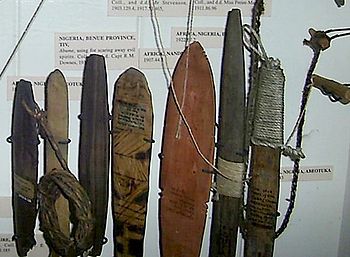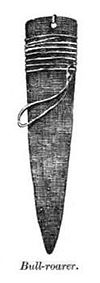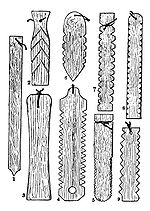
Bullroarer (music)
Encyclopedia

Ukraine
Ukraine is a country in Eastern Europe. It has an area of 603,628 km², making it the second largest contiguous country on the European continent, after Russia...
dating from 17,000 BC. Anthropologist Michael Boyd, a Bullroarer expert, documents a number found in Europe, Asia, the Indian sub-continent, Africa, the Americas, and Australia.
In ancient Greece it was a sacred instrument used in the Dionysian Mysteries
Dionysian Mysteries
The Dionysian Mysteries were a ritual of ancient Greece and Rome which used intoxicants and other trance-inducing techniques to remove inhibitions and social constraints, liberating the individual to return to a natural state. It also provided some liberation for those marginalized by Greek...
and is still used in rituals worldwide.
Along with the didgeridoo
Didgeridoo
The didgeridoo is a wind instrument developed by Indigenous Australians of northern Australia around 1,500 years ago and still in widespread usage today both in Australia and around the world. It is sometimes described as a natural wooden trumpet or "drone pipe"...
, it is prominent technology among Australian Aborigines, used in ceremony across the continent.
The bullroarer is sometimes used as a means of demonstrating the Doppler effect
Doppler effect
The Doppler effect , named after Austrian physicist Christian Doppler who proposed it in 1842 in Prague, is the change in frequency of a wave for an observer moving relative to the source of the wave. It is commonly heard when a vehicle sounding a siren or horn approaches, passes, and recedes from...
in sound waves. As the instrument travels around its circular path, its perceived pitch will, to a third party, appear to rise and fall as it moves closer and farther away, respectively.
Design, use, and sound
A bullroarer consists of a weighted aerofoil (a rectangular thin slat of woodWood
Wood is a hard, fibrous tissue found in many trees. It has been used for hundreds of thousands of years for both fuel and as a construction material. It is an organic material, a natural composite of cellulose fibers embedded in a matrix of lignin which resists compression...
about (6 in) to (24 in) long and about (0.5 in) to (2 in) wide) attached to a long cord
Rope
A rope is a length of fibres, twisted or braided together to improve strength for pulling and connecting. It has tensile strength but is too flexible to provide compressive strength...
. Typically, the wood slat is trimmed down to a sharp edge around the edges, and serrations along the length of the wooden slat may or may not be used, depending on the cultural traditions of the region in question.
The cord is given a slight initial twist, and the roarer is then swung in a large circle in a horizontal plane, or in a smaller circle in a vertical plane. The aerodynamics
Aerodynamics
Aerodynamics is a branch of dynamics concerned with studying the motion of air, particularly when it interacts with a moving object. Aerodynamics is a subfield of fluid dynamics and gas dynamics, with much theory shared between them. Aerodynamics is often used synonymously with gas dynamics, with...
of the roarer will keep it spinning about its axis even after the initial twist has unwound. The cord winds fully first in one direction and then the other, alternating.
It makes a characteristic roaring vibrato
Vibrato
Vibrato is a musical effect consisting of a regular, pulsating change of pitch. It is used to add expression to vocal and instrumental music. Vibrato is typically characterised in terms of two factors: the amount of pitch variation and the speed with which the pitch is varied .-Vibrato and...
sound
Sound
Sound is a mechanical wave that is an oscillation of pressure transmitted through a solid, liquid, or gas, composed of frequencies within the range of hearing and of a level sufficiently strong to be heard, or the sensation stimulated in organs of hearing by such vibrations.-Propagation of...
with notable sound modulations occurring from Doppler effect
Doppler effect
The Doppler effect , named after Austrian physicist Christian Doppler who proposed it in 1842 in Prague, is the change in frequency of a wave for an observer moving relative to the source of the wave. It is commonly heard when a vehicle sounding a siren or horn approaches, passes, and recedes from...
, the changing speed of the roarer travelling at different parts of its circular path, the rotation of the roarer along its longitudinal axis, and the choice of whether a shorter or longer length of cord is used to spin the bullroarer. By modifying the expansiveness of its circuit and the speed given it, and whether a horizontal plane or a vertical plane is used, the modulation of the sound produced can be controlled, making the coding of information possible. The low frequency component of the sound travels extremely long distances, with the sound being clearly audible over many miles on a quiet night.
Used variously as musical instruments, ritualistic devices, and long range communication devices, many cultures have used bullroarers over at least the last 19,000 years. For example, due to the eerie sound produced, bullroarers were used extensively in late 19th and early 20th Century America in the South, for playing elaborate practical jokes on superstitious country dwellers.
In culture
| North American Indian Bullroarers. | ||
|---|---|---|
 |
 |
 |
"making cold" |
This instrument has been used by numerous early and traditional cultures in both the northern
Northern Hemisphere
The Northern Hemisphere is the half of a planet that is north of its equator—the word hemisphere literally means “half sphere”. It is also that half of the celestial sphere north of the celestial equator...
and southern hemisphere
Southern Hemisphere
The Southern Hemisphere is the part of Earth that lies south of the equator. The word hemisphere literally means 'half ball' or "half sphere"...
s but in the popular consciousness it is perhaps best known for its use by Australian Aborigines (it is from one of their languages that the name turndun comes).
Australian Aboriginal culture
Bullroarers have accompanied the didgeridoos in initiation ceremonies and in burialBurial
Burial is the act of placing a person or object into the ground. This is accomplished by excavating a pit or trench, placing an object in it, and covering it over.-History:...
s to ward off evil spirits, bad tidings, and even women and children.
Bullroarers are considered secret men's business by some Aboriginal tribal groups, and hence forbidden for women, children, non-initiated men, or outsiders to even hear. Fison and Howitt documented this in "Kamilaroi and Kurnai" (page198). Anyone caught breaching the imposed secrecy was to be punished by death.
They are used in men's initiation ceremonies and the sound they produced is considered by some Indigenous cultures to represent the sound of the Rainbow Serpent
Rainbow Serpent
The Rainbow Serpent is a common motif in the art and mythology of Aboriginal Australia. It is named for the snake-like meandering of water across a landscape and the colour spectrum caused when sunlight strikes water at an appropriate angle relative to the observer.The Rainbow Serpent is seen as...
. In the cultures of South-East Australia, the sound of the bullroarer is the voice of Daramulan, and a successful bullroarer can only be made if it has been cut from a tree containing his spirit.
In 1987, Midnight Oil
Midnight Oil
Midnight Oil , were an Australian rock band from Sydney originally performing as Farm from 1972 with drummer Rob Hirst, bass guitarist Andrew James and keyboard player/lead guitarist Jim Moginie...
included a recording of a bullroarer on their album Diesel and Dust
Diesel and Dust
Diesel and Dust is an album by Midnight Oil that was released in 1987 under the CBS record label.The album is a concept album about the struggles of the Australian Aborigines and environmental causes, issues both near and dear to the band, and drew inspiration from the Black Fella White Fella tour...
(at the beginning of the song, Bullroarer) inadvertently causing offence to the Aboriginal people of Central Australia
Central Australia
Central Australia/Alice Springs Region is one of the five regions in the Northern Territory. The term Central Australia is used to describe an area centred on Alice Springs in Australia. It is sometimes referred to as Centralia; likewise the people of the area are sometimes called Centralians...
from whom the recording was taken.
The bullroarer can also be used as a tool in Aboriginal art.
Bullroarers have sometimes been referred to as "wife-callers" by Australian Aborigines.
A bullroarer is used by Paul Hogan
Paul Hogan
Paul Hogan, AM is an Australian actor best known for his role as Michael "Crocodile" Dundee from the Crocodile Dundee film series, for which he won a Golden Globe award.-Early life and career:...
in the 1988 film Crocodile Dundee II
Crocodile Dundee II
"Crocodile" Dundee II is a 1988 Australian adventure and comedy film. It is a sequel to the 1986 film "Crocodile" Dundee, and was followed by 2001's Crocodile Dundee in Los Angeles...
. John Antill
John Antill
John Henry Antill, CMG, OBE was an Australian composer best known for his ballet Corroboree.-Biography:Antill was born in Sydney in 1904, and was educated and trained in music at Trinity Grammar School, Sydney and St Andrew's Cathedral School. Upon leaving school in 1920 he became apprenticed to...
included one in the orchestration of his ballet
Ballet
Ballet is a type of performance dance, that originated in the Italian Renaissance courts of the 15th century, and which was further developed in France and Russia as a concert dance form. The early portions preceded the invention of the proscenium stage and were presented in large chambers with...
Corroboree
Corroboree
A corroboree is a ceremonial meeting of Australian Aborigines. The word was coined by the European settlers of Australia in imitation of the Aboriginal word caribberie. At a corroboree Aborigines interact with the Dreamtime through dance, music and costume. Many ceremonies act out events from the...
.

British Isles
In the British Isles, the bullroarer—under a number of different names and styles—is used chiefly for amusement, although formerly it may have been used for ceremonial purposes. In parts of Scotland it was known as a "thunder-spell" and protected against being struck by lightning. In the novel Gentian Hill, set in Devonshire, Great Britain in the early 19th century, a bullroarer figures as a toy cherished by Sol, an elderly farm labourer, who being non-verbally gifted uses it occasionally to express strong emotion; however, the sound it makes is perceived as being both eerie and unlucky by two other main characters, Stella and Zachary, who have an uneasy sense that ominous spirits of the air ("Them") are being invoked by its whirring whistle.Mali
The DogonDogon people
The Dogon are an ethnic group living in the central plateau region of Mali, south of the Niger bend near the city of Bandiagara in the Mopti region. The population numbers between 400,000 and 800,000 The Dogon are best known for their religious traditions, their mask dances, wooden sculpture and...
use bullroarers to announce the beginning of ceremonies conducted during the Sigui festival held every sixty years over a seven year period. It has been identified as being the voice of an ancestor from whom all Dogon are descended.
North American Indian
Almost all the Indian tribes in North America used bullroarers in religious and healing ceremonies and as toys. There are many styles.Other sources
- Franciscan Fathers. An Ethnologic Dictionary of the Navaho Language. Saint Michaels, Arizona: Navajo Indian Mission (1910.
- Haddon, Alfred C. The Study of Man. New York: G.P. Putnam's Sons (1898).
- Kroeber, A.L. "Ethnology of the Gros Ventre", Anthropological Papers of the American Museum of Natural History pp. 145–283. New York: Published by Order of the Trustees (1908).
- Powell, J.W. (Director). Ninth Annual Report of the Bureau of Ethnology to the Secretary of the Smithsonian Institution 1887-'88. Washington, D.C.: Government Printing Office (1892).
- Hart, Mickey Planet Drum, A Celebration of Percussion and Rhythm pp. 154–155. New York: HarperCollins (1991).

